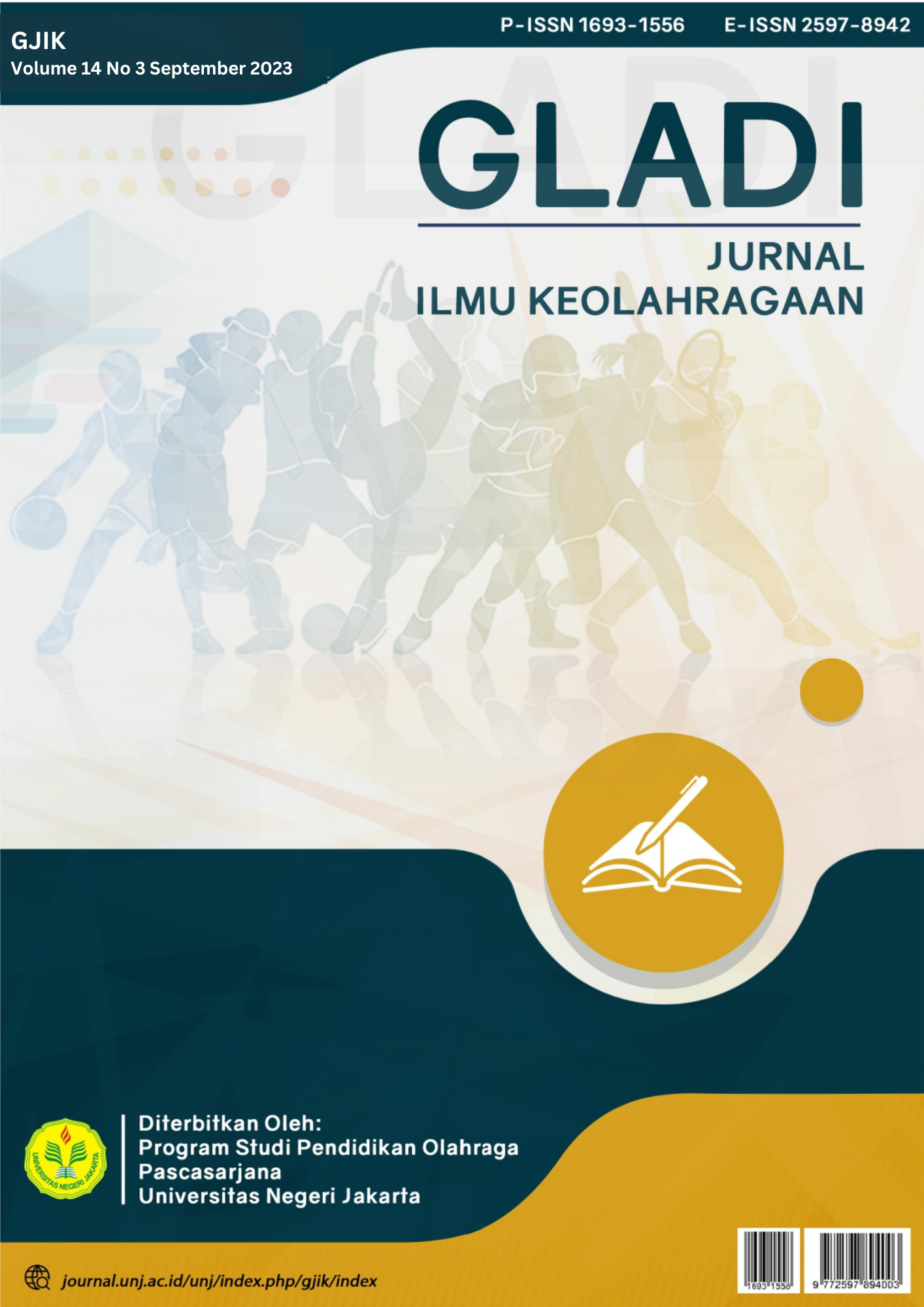Literature Review: Sedentary Behavior In Outdoor Education Learning Elementary School Students
DOI:
https://doi.org/10.21009/GJIK.143.03Keywords:
Outdoor Learning, Sedentary BehaviorAbstract
Sedentary behavior is a wakeful behavior or activity characterized by expenditure of energy such as sitting or lying down, as distinct from passive behavior. Sedentary behavior in outdoor education learning is a learning strategy that is carried out outdoors. Learning strategies like this are carried out by inviting students to unite with nature and do some outdoor activities. The purpose of this study was to determine the factors of sedentary behavior in outdoor education learning. Method: This study uses a literature study approach. Article search used 2 databases, namely Google Scholar and Pubmed with the keywords outdoor education and sedentary behavior. The criteria for the article are original published from 2013 to 2023. Results: Of the 16 articles that have been reviewed, the results show that all articles explain sedentary habits as bad habits that are prone to disease. There fore outdoor learning is one of the factors to reduce the occurrence of diseases that come as a result of sedentary habits, because a child will be more active and move a lot when outside the room. Conclusion: The results of the review of the 16 articles explained that there are factors that influence sedentary behavior in a child which can make a child lazy to move and do other activities. There fore outdoor learning is one of the supporting factors for reducing the occurrence of diseases that come as a result of sedentary habits, because a child will be more active and move a lot when outside the room
Downloads
References
Ambarita, DDL, Prabawati, D., & Hidayah, AJ (2022). The Relationship between Sedentary Lifestyle and the High Incidence of Prediabetes in the Work Area of the Johar Baru Health Center. Stikes Hang Tuah Surbaya Scientific Journal of Nursing, 17(1), 1–5. https://doi.org/10.30643/jiksht.v17i1.146
Ansori. (2015). Out Door Learning Method. Education, 3(4), 49–58.
Apriliani, IM, Purba, NP, Dewanti, LP, Herawati, H., & Faizal, I. (2021). Open access Open access. Citizen-Based Marine Debris Collection Training: Case Study in Pangandaran, 2(1), 56–61.
Arihandayani, Y., & Martha, E. (2020). Sedentary Behavior of Middle School Students in Cibinong District, Bogor Regency, West Java, 2018. Journal of Health Ecology, 19(1), 76–83. https://doi.org/10.22435/jek.v19i1.2685
Arundhana, AI, Hadi, H., & Julia, M. (2016). Sedentary behavior as a risk factor for obesity in elementary school children in Yogyakarta City and Bantul Regency. Indonesian Journal of Nutrition and Dietetics (Indonesian Journal of Nutrition and Dietetics), 1(2), 71. https://doi.org/10.21927/ijnd.2013.1(2).71-80
Becker, C., Lauterbach, G., Spengler, S., Dettweiler, U., & Mess, F. (2017). Effects of regular classes in outdoor education settings: A systematic review on students' learning, social and health dimensions. International Journal of Environmental Research and Public Health, 14(5), 1–20. https://doi.org/10.3390/ijerph14050485
Elementary, S. (2017). Implementation of outdoor education on the character building of elementary school students. 9(apr.), 48–58.
Destira, F., & Mariani, M. (2021). Relationship between sedentary behavior and blood pressure values in college students. Sriwijaya Journal of Medicine, 4(1), 46–54. https://doi.org/10.32539/sjm.v4i1.205
Eliasa, EI (2014). Increasing Values of Teamwork and Responsibility of the Students through Games: Integrating Education Character in Lectures. Procedia - Social and Behavioral Sciences, 123, 196–203. https://doi.org/10.1016/j.sbspro.2014.01.1415
Fadilah, N., Antoni, C., & Lubis, EM (2021). Strengthening Non-Technical Skills of Vocational Students Through Outdoor Learning in Civics Courses. Journal of Moral and Civic Education, 5(2), 115–122. https://doi.org/10.24036/8851412522021529
Fajana, F. (2018). Determinant factors of sedentary lifestyle in adolescents. Muhammadiyah University of Semarang, 16, 1–9. http://repository.unimus.ac.id/2503/4/BAB II.pdf
Ishariani, L. (2020). Use of Gadgets and Sedentary Behavior in Preschool-aged Children in Aisyah Bustanul Athfal Iii Pare Kindergarten. Pamenang Scientific Journal, 2(1), 36–40. https://doi.org/10.53599/jip.v2i1.62
Kamaruddin, I., Anwar, F., Kustiyah, L., & Riyadi, H. (2022). Eating Behavior and Sedentary Activities in Overnourished Adolescents at SMP Negeri 4 Samarinda City: A Cross-Sectional Study. Journal of Health, 9(3), 166–172. https://doi.org/10.25047/jkes.v9i3.248
Los, UMDECDE (n.d.). No 主観的健康感を中心とした在宅高齢者における 健康関連指標に関する共分散構造分析Title. 3, 114–131.
Ludyanti, LN (2019). Sedentary Behavior with Psychosocial Development of Pre-School Children. Care : Scientific Journal of Health Sciences, 7(2), 22. https://doi.org/10.33366/jc.v7i2.1290
Meilina, SD, & Kusuma, DA (2022). Profile of Students' Physical Activity and Sendentary Behavior During the COVID-19 Pandemic on the Island of Java. Sporta Saintika, 7(1), 1–17. https://doi.org/10.24036/sporta.v7i1.208
Pradany, RN, Nursalam, N., & Efendy, F. (2020). Peer Intentions for Increasing Support in Preventing Adolescent Sedentary Behavior. Journal of Health Research “SUARA FORIKES” (Journal of Health Research “Forikes Voice”), 11(3), 319. https://doi.org/10.33846/sf11319
Ramadhani, DY, & Bianti, RR (2017). Physical Activity with Sedentary Behavior in Children Aged 9-11 Years at Sdn Kedurus III/430 Kedurus Village, Karang Pilang District, Surabaya. Adi Husada Nursing Journal, 3(2), 27–33.
Ramsden, R., Han, CS, Mount, D., Loebach, J., Cox, A., Herrington, S., Bundy, A., Fyfe-Johnson, A., Sandseter, EBH, Stone, M., Tremblay, MS, & Brussoni, M. (2022). An Intervention to Increase Outdoor Play in Early Childhood Education Centers (PROmoting Early Childhood Outside): Protocol for a Pilot Wait-list Control Cluster Randomized Trial. JMIR Research Protocols, 11(7), 1–17. https://doi.org/10.2196/38365
Sara, K., Risma, R., & Sutisna, N. (2020). The Relationship between Sleep Duration and Sedentary Behavior with Body Mass Index in SMA Negeri 3 Ciamis Students. Journal of Applied Sports Science, 5(2), 120–127. https://doi.org/10.17509/jtikor.v5i2.27960
Street, M., Wt, L., & Goodman, JF (2010). Early Education & Development. November 2013, 37–41.https://doi.org/10. 1207/s1556 6935 eed1101
Subagyo, RU, & Fithroni, H. (2022). Identification of Sedentary Behavior in Elementary School Students at SDN 195. Journal of Sports Health, 10(03), 195–202.
Tangkudung, J., & Puspitorini, W. (2012). Sports Coaching Sports Achievement Development. Smart Jaya.
Waromi, SL, Antari, NKAJ, Saraswati, PAS, & Tianing, NW (2022). Sedentary Behavior on Functional Abilities in the Elderly in Kukuh Village, Kerambitan, Tabanan, Bali. Indonesian Physiotherapy Scientific Magazine, 10(3), 155. https://doi.org/10.24843/mifi.2022.v10.i03.p05
Yulianti, I., Elies, M., and Faisal, I. (2018). THE RELATIONSHIP BETWEEN SEDENTARY BEHAVIOR AND OBESITY IN ADOLESCENTS AT SMP NEGERI 1 MOJOANYAR MOJOKERTO Indra. Solar Journal, 10(1), 1–5.
Yuliariatiningsih, MS (2018). Outdoor Play Activities In Learning In Kindergarten. Early Horizons: Journal of Early Childhood Education, 6(1), 45–48. https://doi.org/10.17509/cd.v6i1.10517
Yusfita, LY (2019). Relationship between sedentary behavior and metabolic syndrome in workers. The Indonesian Journal of Public Health, 13(2), 145. https://doi.org/10.20473/ijph.v13i2.2018.145-157







